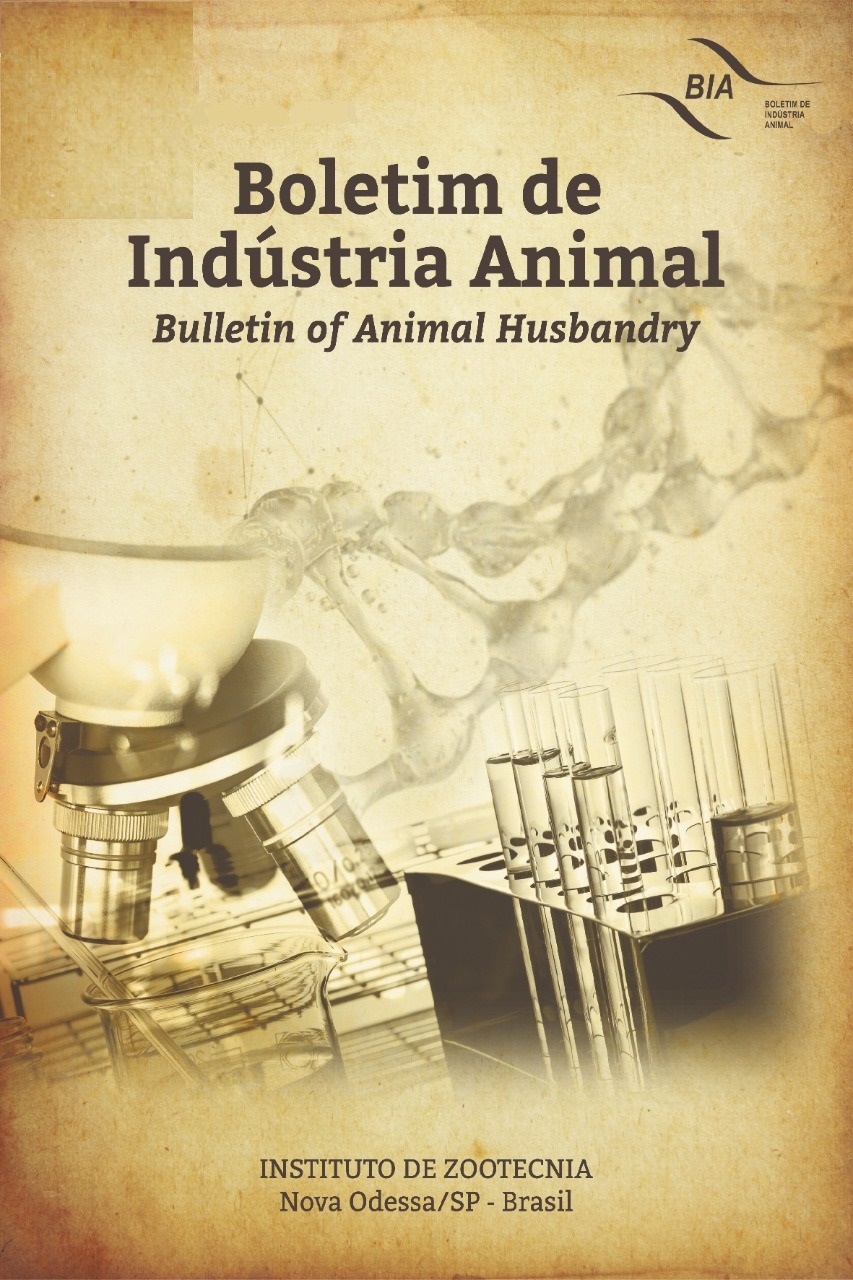Fator P® evaluation, an organic additive, in the feeding of lactating Holstein ¾ Cows to reduce infestations By Rhipicephalus (Boophilus) Microplus
DOI:
https://doi.org/10.17523/bia.2025.v82.e1941Palavras-chave:
Acaricide efficacy, alternative control, animal nutritionResumo
Due the losses caused by the Rhipicephalus (boophilus) microplus tick in dairy cattle in several countries, this research evaluated the action of Factor P® as an aid in this ectoparasite control. This organic additive is supplied daily in the diet through supplementation. For this, 20 lactating Holstein cows were selected. The animals were divided into two groups, Treated Group (TG) and Control Group (CG). The animals were stratified based on the count of telegynes above 4.5 mm, present on the left side of each animal. To evaluate the action of the additive, counts were performed on days 3, 5, 7, 14, 21, 28, 57, 86, 115, 144, 172, 200, 227, 254 and 281 after the beginning of treatment. Over the 281 days, the control group received 28 sprays and the group treated with Factor P® received 10 sprays, 64% fewer interventions. Thus, it is concluded that the additive had an auxiliary effect in the control of bovine ticks, reducing the percentage of infestation, the use of acaricides and reducing additional management, favoring animal and environmental well-being with cost reduction, since using the additive Factor P®, the milk doesn't need to be discarded as in the case of conventional treatment.
Downloads
Referências
ABOELHADID, S. M.; ARAFA, W. M.; MAHROUS, L. N.; FAHMY, M. M.; KAMEL, A. A. Molecular detection of Rhipicephalus (Boophilus) annulatus resistance against deltamethrin in middle Egypt. Veterinary Parasitology: Regional Studies and Reports, v. 13, p. 198–204. 2018. https://doi.org/10.1016/j.vprsr.2018.06.008
ALMEIDA JUNIOR, S.; OZELIN, S. Fundamentos de controle de qualiade na produção, beneficiamento e industrialização do leite bovino. Revista Investigação, v. 16, n.8, p. 76–81, 2017. https://doi.org/10.26843/investigacao.v16i8.1833
ANDREOTTI, R.; GARCIA, M. V.; REIS, F. A.; RODRIGUES, V. D. S.; BARROS, J. C. Controle de carrapatos em sistemas de produção de bovinos associado ao manejo nutricional no campo. Brasília, DF: Embrapa, 2019. http://www.alice.cnptia.embrapa.br/alice/handle/doc/1107106
BARRETA, D. A.; NOTTAR, L. A.; SEGAT, J. C.; BARETTA, D. Production, nutritive value and estimated milk yield from intercropped pastures of cold season. Brazilian Journal of Veterinary and Animal Science, v. 72, p. 599–606, 2020. https://doi.org/10.1590/1678-4162-11436
BECK, B. M.; SILVA, D. J. C.; FASOLO, R.; SERPA, N. P.; MENDES, A. A. Analysis of logistics management and of relationships between fridge and of beef cattle supplier. Exacta EP – Production Engineering. v. 19, n. 2, 2021. https://doi.org/10.5585/exactaep.2021.13236
BURDICK SANCHEZ, N. C.; BROADWAY, P. R.; CARROLL, J. A. Pre-and probiotic effects on innate immunity and metabolism in cattle and swine. In: Gut Microbiota, Immunity, and Health in Production Animals. Cham: Springer International Publishing, 2022. p. 277-297. https://doi.org/10.1007/978-3-030-90303-9_14
CRUZ, B. C.; LIMA MENDES, A. F.; MACIEL, W. G.; SANTOS, I. B.; GOMES, L. V. C.; FELIPPELLI, G.; TEIXEIRA, W. F. P.; FERREIRA, L. L.; SOARES, V. E.; LOPES, W. D. Z.; COSTA, A. J.; OLIVEIRA, G. P. Biological parameters for Rhipicephalus microplus in the field and laboratory and estimation of its annual number of generations in a tropical region. Parasitology Research, v. 119, n.8, p.2421–2430, 2020. https://doi.org/10.1007/s00436-020-06758-5
DOLENGA, C. J. R.; ANJOS, A. D.; BARBOSA, V. H. G.; YOSHITANI, U. Y.; CASTILHO, P. L. D. S. P.; MIYAKAWA, V. I.; MOLENTO, M. B. Acaricidal effect of major compounds to control Rhipicephalus microplus (Canestrini, 1887) in dairy cows and possible alternatives for reversing multidrug resistance. Revista Brasileira de Parasitologia Veterinária, v. 31, n. 2, p. e005422, 2022.
DE MENDONÇA, A. É.; MOREIRA, R. G.; AMARAL, M. D. P. H.; OLIVEIRA MONTEIRO, C. M.; MELLO, V.; VILELA, F. M. P.; CHAGAS, E. F. Entomopathogenic nematodes in pharmaceutical formulations for Rhipicephalus microplus (Acari: Ixodidae) control: In vitro evaluation of compatibility, thermotolerance, and efficiency. Ticks and Tick-Borne Diseases, v.10, n.4, p.781–786. 2019. https://doi.org/10.1016/j.ttbdis.2019.03.012
EMBRAPA - EMPRESA BRASILEIRA DE PESQUISA AGROPECUÁRIA. Anuário Leite 2021. Available in: https://www.embrapa.br/busca-de-publicacoes/-/publicacao/1132875/anuario-leite-2021-saude-unica-e-total Access at: March 7th. 2021.
FIGUEIREDO, C. B.; SANTANA JÚNIOR, H. A.; BEZERRA, L. R.; MENDES, F. B. L.; SANTANA, E. O. C.; ABREU FILHO, G. Correlations between production and economic variables in dairy cows on a tropical pasture. Acta Scientiarum. Animal Sciences, v. 40, 2018. https://doi.org/10.4025/actascianimsci.v40i1.39737.
GETAHUN ASEBE, Y. H.; BASU, A.; SHIBRU, D. Overview of the Biology, Epidemiology and Control Methods Against Hard Ticks: A Review. Global Journals Inc, 2016.
GRISI, L.; LEITE, R. C.; MARTINS, J. R. S.; BARROS, A. T. M.; ANDREOTTI, R.; CANÇADO, P. H. D.; LEÓN, A. A. P.; PEREIRA, J. B.; VILLELA, H. S. Reassessment of the potential economic impact of cattle parasites in Brazil. Brazilian Journal of Veterinary Parasitology, v.23, p.150–156, 2014. https://doi.org/10.1590/S1984-29612014042
HENRIQUES, R. F.; PEREIRA, F. B.; PAIVA, J. T.; SILVA, M. A.; MELO, R. M. P. S. Profile of endoparasites in dairy cattle in the microregion of São João del-Rei, state of Minas Gerais, Brazil. Brazilian Journal of Veterinary and Animal Science, v. 73, p. 25-33, 2021. https://doi.org/10.1590/1678-4162-12013
HERNÁNDEZ-ORTIZ, RUBÉN. Laboratory maintenance of rhipicephalus (boophilus) microplus. A Laboratory Manual on Rhipicephalus microplus, p. 30, 2023.
LATROFA, M. S.; DANTAS-TORRES, F.; GIANNELLI, A.; OTRANTO, D. Molecular detection of tick-borne pathogens in Rhipicephalus sanguineus group ticks. Ticks and tick-borne diseases, v. 5, n. 6, p. 943-946, 2014. https://doi.org/10.1016/j.ttbdis.2014.07.014.
LEITE, R. G.; ROMANZINI, E. P.; DELEVATTI, L. M.; HOFFMANN, A.; FERRARI, A. C.; D'AUREA, A. P.; FERNANDE, L. B.; OLIVEIRA, A. P.; REIS, R. A. Organic additives used in beef cattle feedlot: Effects on metabolic parameters and animal performance. Animal Science Journal, v. 90, n. 5, p. 628-636, 2019. https://doi.org/10.1111/asj.13183
MIRABALLES, C.; RIET-CORREA, F. A review of the history of research and control of Rhipicephalus (Boophilus) microplus, babesiosis and anaplasmosis in Uruguay. Experimental and Applied Acarology, v.75, n.4, p.383-398, 2018. https://doi.org/10.1007/s10493-018-0278-3
MOLENTO, M. B. Avaliação seletiva de bovinos para controle do Rhipicephalus microplus. Ars Veterinaria, v. 36, n. 1, p. 01-02, 2020.
MONTEIRO, C. A.; CANNON, G.; MOUBARAC, J.-C.; MARTINS, A. P. B.; MARTINS, C. A.; GARZILLO, J.; CANELLA, D. S.; BARALDI, L. G.; BARCIOTTE, M.; LOUZADA, M. L. C.; LEVY, R. B.; CLARO, R. M.; JAIME, P. C. Dietary guidelines to nourish humanity and the planet in the twenty-first century. A blueprint from Brazil. Public Health Nutrition, v.18, n.13, p.2311–2322, 2015. https://doi.org/10.1017/S1368980015002165
NICARETTA, J. E.; ZAPA, D. M. B.; COUTO, L. F. M.; HELLER, L. M.; ASSIS CAVALCANTE, A. S.; CRUVINEL, L. B.; LOPES, W. D. Z. Rhipicephalus microplus seasonal dynamic in a Cerrado biome, Brazil: An update data considering the global warming. Veterinary Parasitology, v. 296, p. 109506, 2021. https://doi.org/10.1016/j.vetpar.2021.109506
SAAD, F. M. D. O. B.; FERREIRA, L. G.; ZANGERONIMO, M. G.; PRADO SAAD, C. E. Nutrição e imunidade em animais de companhia. Caderno de Ciências Agrárias, 2015. https://periodicos.ufmg.br/index.php/ccaufmg/article/view/2813
SANTOS, G. B.; GOMES, I. M. M.; SILVEIRA, J. A. G.; PIRES, L. C. S. R.; AZEVEDO, S. S.; ANTONELLI, A. C.; RIBEIRO, M. F. B.; HORTA, M. C. Cattle Tick Fever in semi-arid of Pernambuco. Brazilian Journal of Veterinary Research, v.37, p.1–7, 2017. https://doi.org/10.1590/S0100-736X2017000100001
SON, A. R.; KIM, S. H.; ISLAM, M.; MIGUEL, M.; NAING, Y. P.; LEE, S. S. Effect of organic mineral supplementation in reducing oxidative stress in Holstein calves during short-term heat stress and recovery conditions. Journal of Animal Science and Biotechnology, v.14, n.1, p.156.
VASCONCELOS, V. O.; MARTINS, M. A. D.; OLIVEIRA, N. J. F.; DUARTE, E. R. Effect of ethanolic extract of Capsicum frutescens L. on adult female of Rhipicephalus microplus (Ixodidae). Parasitology Research, v.113, n.4, p.1389–1394, 2014. https://doi.org/10.1007/s00436-014-3779-y
VONA, R.; SPOSI, N. M.; MATTIA, L.; GAMBARDELLA, L.; STRAFACE, E.; PIETRAFORTE, D. Sickle cell disease: role of oxidative stress and antioxidant therapy. Antioxidants, 2021. https://doi.org/10.3390/antiox10020296
WHARTON, R. H.; UTECH*, K. B. W. The Relation Between Engorgement and Dropping of Boophilus Microplus (canestrini) (ixodidae) to the Assessment of Tick Numbers on Cattle. Australian Journal of Entomology, v.9, n.3, p.171–182, 1970. https://doi.org/10.1111/j.1440-6055.1970.tb00788.x
WU, D.; LEWIS, E. D.; PAE, M.; MEYDANI, S. N. Nutritional Modulation of Immune Function: Analysis of Evidence, Mechanisms, and Clinical Relevance. Frontiers in Immunology, v.9, 2019. https://doi.org/10.3389/fimmu.2018.03160
Downloads
Publicado
Edição
Seção
Licença
Copyright (c) 2025 Boletim de Indústria Animal

Este trabalho está licenciado sob uma licença Creative Commons Attribution-NonCommercial-NoDerivatives 4.0 International License.
Os autores não serão remunerados pela publicação de trabalhos, pois devem abrir mão de seus direitos autorais em favor deste periódico. Por outro lado, os autores ficam autorizados a publicar seus artigos, simultaneamente, em repositórios da instituição de sua origem, desde que citada a fonte da publicação original seja Boletim de Indústria Animal. A revista se reserva o direito de efetuar, nos originais, alterações de ordem normativa, ortográfica e gramatical, com vistas a manter o padrão culto da língua e a credibilidade do veículo. Respeitará, no entanto, o estilo de escrever dos autores. Alterações, correções ou sugestões de ordem conceitual serão encaminhadas aos autores, quando necessário. Nesses casos, os artigos, depois de adequados, deverão ser submetidos a nova apreciação. As opiniões emitidas pelos autores dos artigos são de sua exclusiva responsabilidade. Todo o conteúdo deste periódico, exceto onde está identificado, está licenciado sob a Licença Creative Commons Attribution (CC-BY-NC). A condição BY implica que os licenciados podem copiar, distribuir, exibir e executar a obra e fazer trabalhos derivados com base em que só se dão o autor ou licenciante os créditos na forma especificada por estes. A cláusula NC significa que os licenciados podem copiar, distribuir, exibir e executar a obra e fazer trabalhos derivados com base apenas para fins não comerciais.













